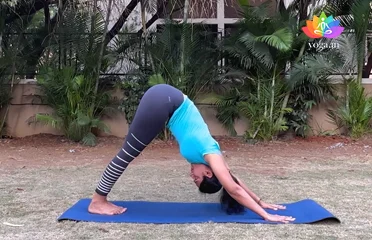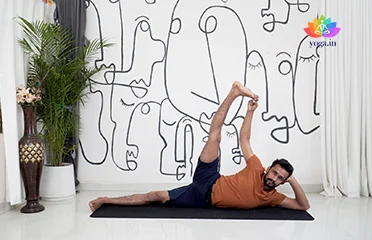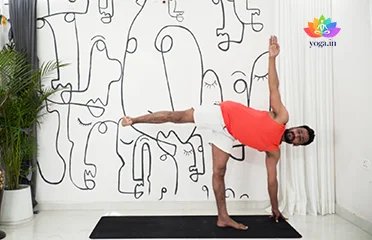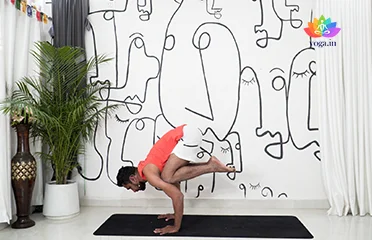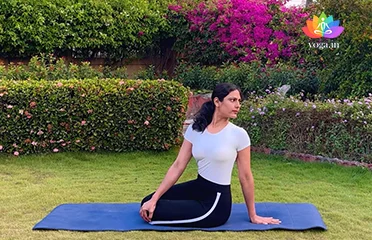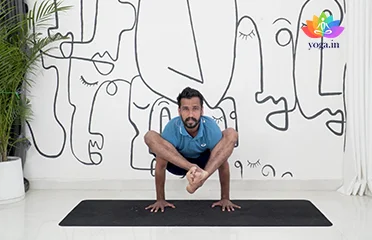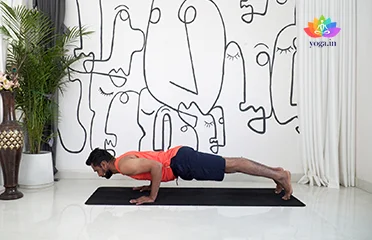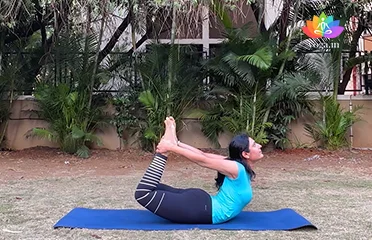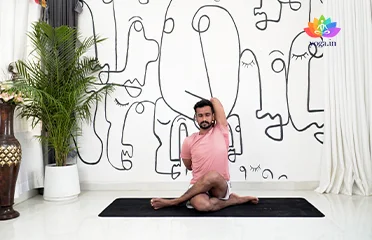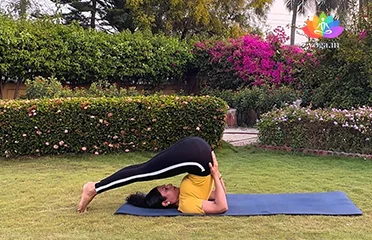Adho Mukha Svanasana (Downward-Facing Do
अधोमुख श्वानासन / Downward-Facing Dog Pose
The sanskrit name is derived from adhas (अधस्) meaning down, mukha [�K]
Anantasana (Sleeping Vishnu Pose)
अनन्तासन / Sleeping Vishnu Pose | Vishnu's Couch Pose
The Sanskrit name is derived from Ananta (अनन्त) meaning without end [�K]
Ardha Chandrasana (Half Moon Pose)
अर्धचन्द्रासना / Half Moon Pose
The Sanskrit name is derived from Ardha (अर्ध) meaning half, Chandra [�K]
Bakasana (Crane Pose)
बकासन / Crane Pose
The Sanskrit name is derived from Baka (बक) meaning crane or Kaka (काक) [�K]
Bharadvajasana (Seated Spinal Twist)
भरद्वाजसन / Seated Spinal Twist
The Sanskrit name is derived from Bhardvaja (भरद्वाज) means bringing [�K]
Bhujapidasana (Shoulder-Pressing Pose)
भुजपीडासन / Shoulder-Pressing Pose
The Sanskrit name is derived from Bhuja (भुज) meaning arm/shoulder, Pida [�K]
Chaturanga Dandasana (Low Plank Pose)
चतुरङ्ग दण्डासन / Low Plank Pose
The Sanskrit name is derived from Chatur (चतुर) meaning four, Anga (अङ्ग) [�K]
Dhanurasana (Bow Pose)
धनुरासन / Bow Pose
The Sanskrit name is derived from Dhanur (धनुर) means bow and Asana [�K]
Gomukhasana (Cow Face Pose)
गोमुखासन / Cow Face Pose
The Sanskrit name is derived from Gau (गो) meaning cow, Mukh meaning face [�K]
Halasana (Plough Pose)
हलासन / Plough Pose
The Sanskrit name is derived from Hala (हला) meaning plough and asana [�K]
- 1
- 2
- 3
Moving with Mindfulness – Yoga for Arthritis of the Shoulder Joints
Yoga can be a valuable tool for managing arthritis in the shoulder joints. However, it’s crucial to approach it with caution and prioritize seeking guidance from a healthcare professional or qualified yoga therapist familiar with arthritis.
What is Arthritis?
Arthritis refers to a group of conditions characterized by inflammation and joint pain. There are various types of arthritis, and understanding yours is essential for determining suitable yoga practices.
Benefits of Yoga for Arthritis of the Shoulder Joints
While yoga doesn’t cure arthritis, it can offer several benefits for managing symptoms:
- Improved Range of Motion: Gentle yoga movements can help maintain and improve flexibility in the shoulder joints, potentially reducing stiffness and pain.
- Pain Management: Yoga practices can promote relaxation and stress reduction, which may indirectly help manage pain perception.
- Strengthening Supportive Muscles: Certain yoga poses can strengthen the muscles surrounding the shoulder joint, improving stability and support.
- Enhanced Body Awareness: Yoga encourages a mindful approach to movement, allowing you to identify areas of discomfort and modify practices accordingly.
Safe Yoga Practices for Arthritis of the Shoulder Joints
Here are some general guidelines for incorporating yoga into your routine when managing shoulder arthritis:
- Focus on Gentle Movement: Prioritize gentle stretches and movements that don’t strain the shoulder joints. Avoid any poses that cause pain or discomfort.
- Maintain Proper Alignment: Focus on maintaining good posture throughout your practice. This can help protect your joints and prevent further strain.
- Modify as Needed: Don’t hesitate to modify yoga poses to suit your individual needs and limitations. Use props like blocks and straps for added support.
- Incorporate Breathwork: Pay attention to your breath throughout your practice. Slow and steady breathing can promote relaxation and enhance focus.
Additional Tips –
- Warm Up: Before starting your yoga practice, perform gentle warm-up exercises to prepare your body for movement.
- Cool Down: After your practice, take time to cool down with gentle stretches and relaxation techniques.
- Consistency is Key: Regular yoga practice, even for short periods, can be more beneficial than infrequent long sessions.
- Listen to Your Body: Always pay attention to your body’s signals. Stop if you experience any pain or discomfort and consult a healthcare professional if needed.
By incorporating these guidelines and seeking guidance from a qualified professional, yoga can become a safe and valuable tool for managing shoulder arthritis.
Important Considerations –
- Consult a Healthcare Professional: It’s important to discuss your specific condition and limitations with a healthcare professional or qualified yoga therapist before starting any yoga practice.
- Focus on Long-Term Management: Yoga is a complementary approach for managing arthritis, not a cure. Consistency and a focus on long-term management are key.
Remember, yoga is a journey of self-discovery and exploration. It’s crucial to find practices that suit your individual needs and conditions. While yoga can be a valuable tool in managing arthritis symptoms, prioritize professional medical advice and always prioritize your well-being.


